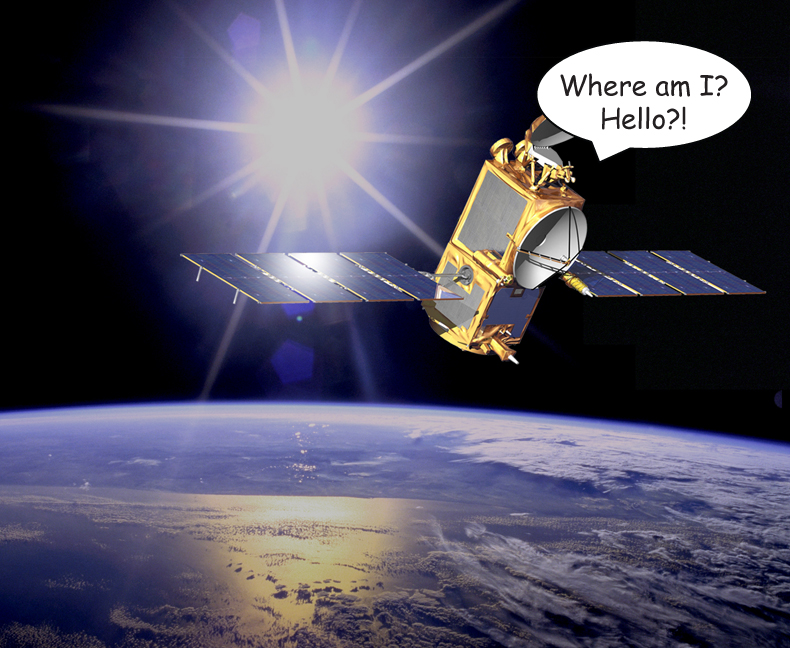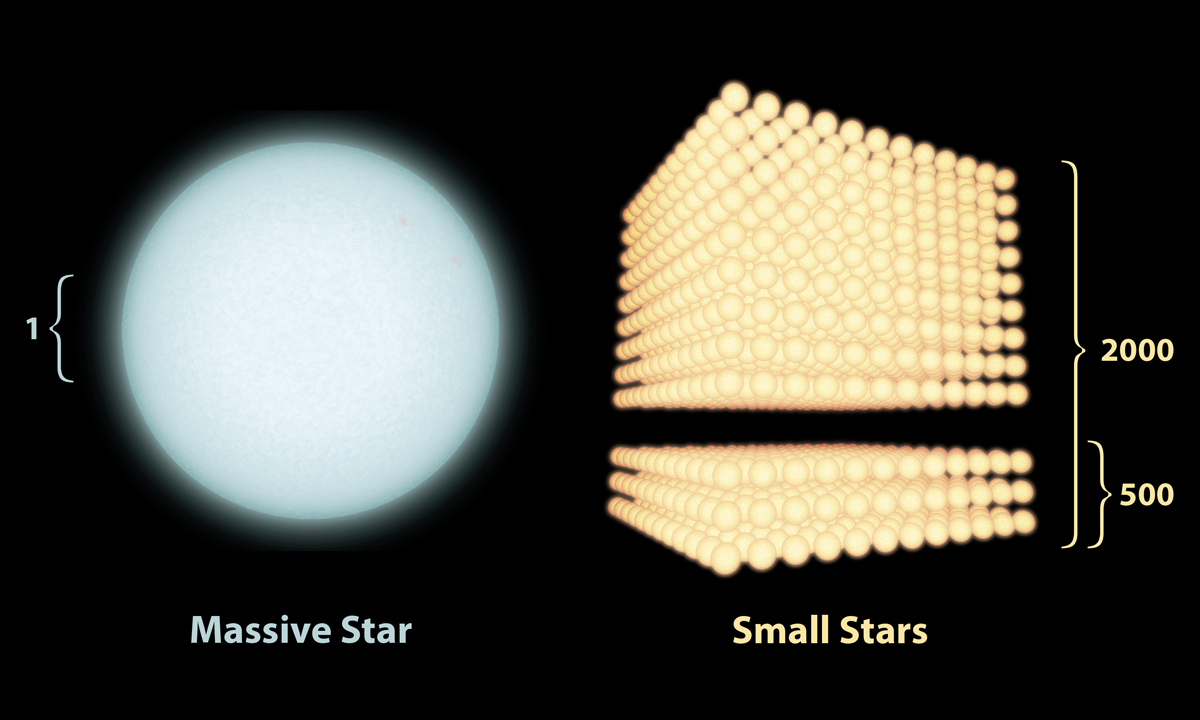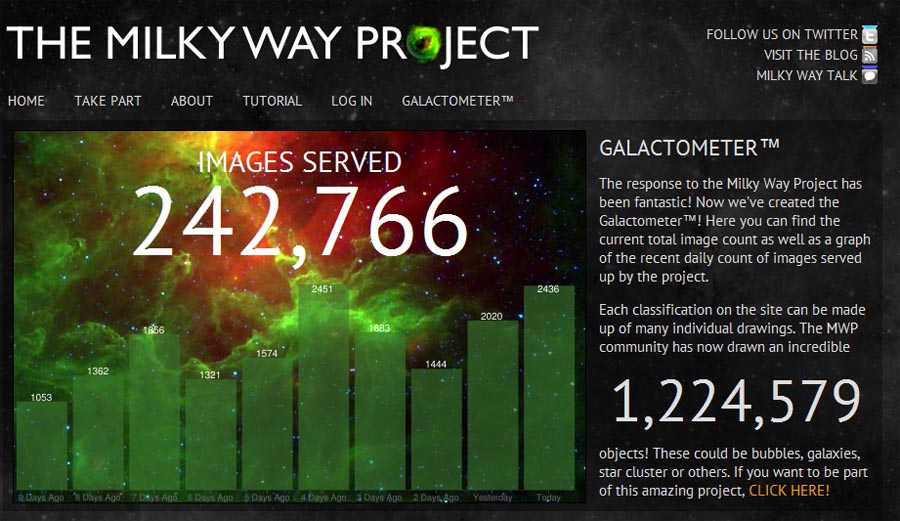Next Launch
Total Students
2,609
Total Launches
683
Eggs Survived
418 61.2%
Rockets Survived
536 78.5%
March 1, 2011
GOES-R, Zombie Fighter
by Dr. Tony Phillips
On April 5, 2010, something eerie happened to the Galaxy 15 telecommunications satellite: It turned into a zombie.
The day began as usual, with industry-owned Galaxy 15 relaying TV signals to millions of viewers in North America, when suddenly the geosynchronous satellite stopped taking commands from Earth. It was brain dead! Like any good zombie, however, its body continued to function. Within days, Galaxy 15 began to meander among other satellites in geosynchronous orbit, transmitting its own signal on top of the others’. Satellite operators scrambled to deal with the interference, all the while wondering what happened?
In horror movies, zombies are usually produced by viruses.
“In this case, the culprit was probably the sun,” says Bill Denig of the National Geophysical Data Center in Boulder, Colorado. He and colleague Janet Green of NOAA’s Space Weather Prediction Center recently led a study of the Galaxy 15 anomaly, and here are their conclusions:
On April 3rd, a relatively minor solar flare launched a cloud of plasma toward Earth. Galaxy 15 had experienced many such events before, but this time there was a difference.
“Galaxy 15 was just emerging from the shadow of Earth when the cloud arrived and triggered a geomagnetic storm,” explains Denig. Suddenly exposed to sunlight and the ongoing storm, “the spacecraft began to heat up and charge [up].”
Electrons swirling around Galaxy 15 stuck to and penetrated the spacecraft’s surface. As more and more charged particles accumulated, voltages began to rise, and—zap!—an electrostatic discharge occurred. A zombie was born.
“At least, this is what we suspect happened based on data collected by GOES satellites in the vicinity,” he says. “We’ll be able to diagnose events like this much better, however, after GOES-R is launched by NASA in 2015.”
GOES-R is NOAA’s next-generation Geostationary Operational Environmental Satellite. One of the instruments it will carry, a low-energy electron counter, is crucial to “zombie fighting.” Low energy-electrons are the ones most likely to stick to a spacecraft’s surface and cause brain-frying discharges. By monitoring these particles in Earth orbit, GOES-R will provide better post-mortems for future zombie outbreaks. This could help satellite designers figure out how to build spacecraft less susceptible to discharges. Also, GOES-R will be able to issue alerts when dangerous electrons appear. Satellite operators could then take protective action—for example, putting their birds in “safe mode”—to keep the zombie population at bay.
Meanwhile, Galaxy 15 is a zombie no more. In late December 2010, after 9 months of terrorizing nearby spacecraft, the comsat was re-booted, and began responding to commands from Earth again.
All’s well that ends well? True zombie fighters know better than to relax. Says Denig, “we’re looking forward to GOES-R.”
You and the kids in your life can learn about space weather at http://scijinks.gov/space-weather-and-us.
This article was provided by the Jet Propulsion Laboratory, California Institute of Technology, under a contract with the National Aeronautics and Space Administration.
 The Galaxy 15 communication satellite was “brainless” for several months in 2010 after being exposed to a geomagnetic storm. The new GOES-R satellite will warn of such dangers.
The Galaxy 15 communication satellite was “brainless” for several months in 2010 after being exposed to a geomagnetic storm. The new GOES-R satellite will warn of such dangers.
April 1, 2011
Cosmic Recount
by Dr. Tony Phillips
News flash: The Census Bureau has found a way to save time and money. Just count the biggest people. For every NBA star like Shaquille O’Neal or Yao Ming, there are about a million ordinary citizens far below the rim. So count the Shaqs, multiply by a million, and the census is done.
Could the Bureau really get away with a scheme like that? Not likely. Yet this is just what astronomers have been doing for decades.
Astronomers are census-takers, too. They often have to estimate the number and type of stars in a distant galaxy. The problem is, when you look into the distant reaches of the cosmos, the only stars you can see are the biggest and brightest. There’s no alternative. To figure out the total population, you count the supermassive Shaqs and multiply by some correction factor to estimate the number of little guys.
The correction factor astronomers use comes from a function called the “IMF”—short for “initial mass function.” The initial mass function tells us the relative number of stars of different masses. For example, for every 20-solar-mass giant born in an interstellar cloud, there ought to be about 100 ordinary sun-like stars. This kind of ratio allows astronomers to conduct a census of all stars even when they can see only the behemoths.
Now for the real news flash: The initial mass function astronomers have been using for years might be wrong.
NASA’s Galaxy Evolution Explorer, an ultraviolet space telescope dedicated to the study of galaxies, has found proof that small stars are more numerous than previously believed.
“Some of the standard assumptions that we've had—that the brightest stars tell you about the whole population—don’t seem to work, at least not in a constant way,” says Gerhardt R. Meurer who led the study as a research scientist at Johns Hopkins University, Baltimore, Md. (Meurer is now at the University of Western Australia.)
Meurer says that the discrepancy could be as high as a factor of four. In other words, the total mass of small stars in some galaxies could be four times greater than astronomers thought. Take that, Shaq!
The study relied on data from Galaxy Evolution Explorer to sense UV radiation from the smaller stars in distant galaxies, and data from telescopes at the Cerro Tololo Inter-American Observatory to sense the “H-alpha” (red light) signature of larger stars. Results apply mainly to galaxies where stars are newly forming, cautions Meurer.
“I think this is one of the more important results to come out of the Galaxy Evolution Explorer mission,” he says. Indeed, astronomers might never count stars the same way again.
Find out about some of the other important discoveries of the Galaxy Evolution Explorer at http://www.galex.caltech.edu/. For an easy-to-understand answer for kids to “How many solar systems are in our galaxy?” go to The Space Place at: http://tiny.cc/I2KMa
This article was provided by the Jet Propulsion Laboratory, California Institute of Technology, under a contract with the National Aeronautics and Space Administration.
 Astronomers have recently found that some galaxies have as many as 2000 small stars for every 1 massive star. They used to think all galaxies had only about 500 small stars for every 1 massive star.
Astronomers have recently found that some galaxies have as many as 2000 small stars for every 1 massive star. They used to think all galaxies had only about 500 small stars for every 1 massive star.
May 1, 2011
Milky Way Safari
by Dauna Coulter and Dr. Tony Phillips
Safari, anyone? Citizen scientists are invited to join a hunt through the galaxy. As a volunteer for Zooniverse's Milky Way Project, you'll track down exotic creatures like mysterious gas bubbles, twisted green knots of dust and gas, and the notorious “red fuzzies.”
“The project began about four months ago,” says astrophysicist Robert Simpson of Oxford University. “Already, more than 18,000 people are scouting the Milky Way for these quarry.”
The volunteers have been scrutinizing infrared images of the Milky Way's inner regions gathered by NASA’s Spitzer Space Telescope. Spitzer's high resolution in infrared helps it pierce the cloaking haze of interstellar gas and dust, revealing strange and beautiful structures invisible to conventional telescopes. The Milky Way Project is helping astronomers catalogue these intriguing features, map our galaxy, and plan future research.
“Participants use drawing tools to flag the objects,” explains Simpson. “So far they've made over a million drawings and classified over 300,000 images.”
Scientists are especially interested in bubble-like objects believed to represent areas of active star formation. “Every bubble signifies hundreds to thousands of young, hot stars. Our volunteers have circled almost 300,000 bubble candidates, and counting,” he says.
Humans are better at this than computers. Computer searches turn up only the objects precisely defined in a program, missing the ones that don't fit a specified mold. A computer would, for example, overlook partial bubbles and those that are skewed into unusual shapes.
“People are more flexible. They tend to pick out patterns computers don't pick up and find things that just look interesting. They're less precise, but very complementary to computer searches, making it less likely we'll miss structures that deserve a closer look. And just the sheer numbers of eyes on the prize mean more comprehensive coverage.”
Along the way the project scientists distill the volunteers' data to eliminate repetitive finds (such as different people spotting the same bubbles) and other distortions.
The project's main site (http://www.milkywayproject.org) includes links to a blog and a site called Milky Way Talk. Here “hunters” can post comments, chat about images they've found, tag the ones they consider especially intriguing, vote for their favorite images (see the winners at http://talk.milkywayproject.org/#/collections/CMWS00002u), and more.
Zooniverse invites public participation in science missions both to garner interest in science and to help scientists achieve their goals. More than 400,000 volunteers are involved in their projects at the moment. If you want to help with the Milky Way Project, visit the site, take the tutorial, and … happy hunting!
You can get a preview some of the bubbles at Spitzer’s own web site, http://www.spitzer.caltech.edu/. Kids will enjoy looking for bubbles in space pictures while playing the Spitzer concentration game at http://spaceplace.nasa.gov/spitzer-concentration/.
This article was provided by the Jet Propulsion Laboratory, California Institute of Technology, under a contract with the National Aeronautics and Space Administration.
 Volunteers study infrared images of our galaxy from the Spitzer Space Telescope, identifying interesting features using the special tools of the Milky Way Project, part of the Citizen Science Alliance Zooniverse web site.
Volunteers study infrared images of our galaxy from the Spitzer Space Telescope, identifying interesting features using the special tools of the Milky Way Project, part of the Citizen Science Alliance Zooniverse web site.
June 1, 2011
Finding Planets Among the Stars
by Dr. Tony Phillips
Strange but true: When it comes to finding new extra-solar planets, or exoplanets, stars can be an incredible nuisance.
It’s a matter of luminosity. Stars are bright, but their planets are not. Indeed, when an astronomer peers across light years to find a distant Earth-like world, what he often finds instead is an annoying glare. The light of the star itself makes the star's dim planetary system nearly impossible to see.
Talk about frustration! How would you like to be an astronomer who's constantly vexed by stars?
Fortunately, there may be a solution. It comes from NASA's Galaxy Evolution Explorer, an ultraviolet space telescope orbiting Earth since 2003. In a new study, researchers say the Galaxy Evolution Explorer is able to pinpoint dim stars that might not badly outshine their own planets.
“We've discovered a new technique of using ultraviolet light to search for young, low-mass stars near the Earth,” said David Rodriguez, a graduate student of astronomy at UCLA, and the study's lead author. “These M-class stars, also known as red dwarfs, make excellent targets for future direct imaging of exoplanets.”
Young red dwarfs produce a telltale glow in the ultraviolet part of the electromagnetic spectrum that Galaxy Evolution Explorer can sense. Because dwarf stars are so numerous—as a class, they account for more than two-thirds of the stars in the galaxy—astronomers could reap a rich bounty of targets.
In many ways, these stars represent a best-case scenario for planet hunting. They are close and in clear lines-of-sight, which generally makes viewing easier. Their low mass means they are dimmer than heavier stars, so their light is less likely to mask the feeble light of a planet. And because they are young, their planets are freshly formed, and thus warmer and brighter than older planetary bodies.
Astronomers know of more than five hundred distant planets, but very few have actually been seen. Many exoplanets are detected indirectly by means of their “wobbles”—the gravitational tugs they exert on their central stars. Some are found when they transit the parent star, momentarily dimming the glare, but not dimming it enough to reveal the planet itself.
The new Galaxy Evolution Explorer technique might eventually lead to planets that can be seen directly. That would be good because, as Rodriguez points out, “seeing is believing.”
And it just might make astronomers feel a little better about the stars.
The Galaxy Evolution Explorer Web site at http://www.galex.caltech.edu describes many of the other discoveries and accomplishments of this mission. And for kids, how do astronomers know how far away a star or galaxy is? Play “How Old do I Look” on The Space Place at http://spaceplace.nasa.gov/whats-older and find out!
This article was provided by the Jet Propulsion Laboratory, California Institute of Technology, under a contract with the National Aeronautics and Space Administration.
 Exoplanets are easier to see directly when their star is a dim, red dwarf.
Exoplanets are easier to see directly when their star is a dim, red dwarf.